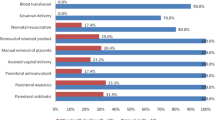Abstract
Objective To establish a baseline for the availability, utilisation and quality of maternal and neonatal health care services for monitoring and evaluation of a maternal and neonatal morbidity/mortality reduction programme in three districts in the Central Region of Malawi. Methods Survey of all the 73 health facilities (13 hospitals and 60 health centres) that provide maternity services in the three districts (population, 2,812,183). Results There were 1.6 comprehensive emergency obstetric care (CEmOC) facilities per 500,000 population and 0.8 basic emergency obstetric care (BEmOC) facilities per 125,000 population. About 23% of deliveries were conducted in emergency obstetric care (EmOC) facilities and the met need for emergency obstetric complications was 20.7%. The case fatality rate for emergency obstetric complications treated in health facilities was 2.0%. Up to 86.7% of pregnant women attended antenatal clinic at least once and only 12.0% of them attend postnatal clinic at least once. There is a shortage of qualified staff and unequal distribution with more staff in hospitals leaving health centres severely understaffed. Conclusions The total number of CEmOC facilities is adequate but the distribution is unequal, leaving some rural areas with poor access to CEmOC services. There are no functional BEmOC facilities in the three districts. In order to reduce maternal mortality in Malawi and countries with similar socio-economic profile, there is a need to upgrade some health facilities to at least BEmOC level by training staff and providing equipment and supplies.

Similar content being viewed by others
References
United Nations. Millennium Development Goals Indicators. http://mdgs.un.org/unsd/mdg/Data.aspx. Accessed on December 10, 2007.
National Statistical Office (Malawi), ORC Macro. (2005). 2004 Malawi Demographic and Health Survey. Calverton: ORC Macro, Maryland.
United Nations Development Programme. Human Development Reports: Human Development Index—going beyond income. http://hdrstats.undp.org/countries/country_fact_sheets/cty_fs_MWI.html. Accessed on January 24, 2008.
WHO. Mortality and burden of disease. http://www.who.int/countries/mwi/en/. Accessed on 10/12/2007.
World Health Organisation. (2004). Maternal mortality in 2000: Estimates developed by WHO, UNICEF, UNFPA. Geneva: Department of Reproductive Health and Research, World Health Organisation.
United Nations. (2006). Progress towards millennium development goals, 1990–2005. New York: Statistics Division, Department of Economics and Social Affairs, United Nations.
Seljeskog, L., Sundby, J., & Chimango, J. (2006). Factors influencing women’s choice of place of delivery in rural Malawi—An explorative study. African Journal of Reproductive Health, 10, 66–75.
Hussein, J., Goodburn, E. A., Damisoni, H., Lema, V., & Graham, W. (2001). Monitoring obstetric services: Putting the ‘UN Guidelines’ into practice in Malawi: 3 years on. International Journal of Gynaecology and Obstetrics: The Official Organ of the International Federation of Gynaecology and Obstetrics, 75, 63–73. doi:10.1016/S0020-7292(01)00474-X.
Ministry of Health (Malawi). WHO, UNICEF, UNFPA. (2004). Assessment of emergency obstetric care in Malawi. Lilongwe: Malawi Ministry of Health.
AMDD Working Group Indicatiors. (2003). Group on indicators. Program note: Using UN process indicators to assess needs in emergency obstetric services: Morocco, Nicaragua and Sri Lanka. International Journal of Gynaecology and Obstetrics: The Official Organ of the International Federation of Gynaecology and Obstetrics, 80, 222–230. doi:10.1016/S0020-7292(02)00390-9.
Paxton, A., Bailey, P., Lobis, S., & Fry, D. (2006). Global patterns in availability of emergency obstetric care. International Journal of Gynaecology and Obstetrics: The Official Organ of the International Federation of Gynaecology and Obstetrics, 93, 300–3007. doi:10.1016/j.ijgo.2006.01.030.
Chaillet, N., & Dumont, A. (2007). Evidence-based strategies for reducing Cesarean Section rates: A meta-analysis. Birth (Berkeley, Calif.), 34, 53–64. doi:10.1111/j.1523-536X.2006.00146.x.
Aziken, M., Omo-Aghoja, L., & Okonofua, F. (2007). Perceptions and attitudes of pregnant women towards Caesarean Section in urban Nigeria. Acta Obstetricia et Gynecologica Scandinavica, 86, 42–47. doi:10.1080/00016340600994950.
Hopkins, K. (2000). Are Brazilian women really choosing to deliver by cesarean? Social Science and Medicine, 51, 725–740. doi:10.1016/S0277-9536(99)00480-3.
Carroli, G., Villar, J., Piaggio, G., Khan-Neelofur, D., Gulmezoglu, M., Mugford, M., et al. (2001). WHO systematic review of randomised controlled trials of routine antenatal care. Lancet, 357, 1565–1570. doi:10.1016/S0140-6736(00)04723-1.
Ghana Statistical SErvice, Noguchi Memorial Institute for Medical Research, ORC Macro. (2003) 2003 Ghana Demographic and Health Survey. Calverton: ORC Macro, Maryland.
National Institute of Statistics, ORC Macro Calverton. (2004). Cameroon Demographic and Health Survey. Calverton: ORC Macro, Maryland.
Ronsmans, C., & Graham, W. J. (2006). Maternal mortality: Who, where, when and why. Lancet, 368, 1189–1200. doi:10.1016/S0140-6736(06)69380-X.
Orach, C. G., Dubourg, D., & De Brouwere, V. (2007). Costs and coverage of reproductive health interventions in three rural refugee-affected districts, Uganda. Tropical Medicine & International Health, 12, 459–469.
Chalmers, B., & Quliyeva, D. (2004). A report of women’s birth experiences in Baku, Azerbaijan. Journal of Psychosomatic Obstetrics and Gynaecology, 25, 3–14. doi:10.1080/01674820410001737397.
Lanata, C. F. (2007). Human resources in developing countries. Lancet, 369, 1238–1239. doi:10.1016/S0140-6736(07)60573-X.
Lewis, G. (2003). Beyond the numbers: Reviewing maternal deaths and complications to make pregnancy safer. British Medical Bulletin, 67, 27–37. doi:10.1093/bmb/ldg009.
Acknowledgements
We wish acknowledge the Health Foundation for providing financial support for this study. We also thank the staff of all the health facilities and the Health Foundation Consortium staff for the cooperation shown during the data collection phase.
Authors' Contribution
EJK wrote the protocol, collected the data, analysed and interpreted the data, and drafted the first copy and all versions of the manuscript. JH and GM participated in data collection. CM and NVDB reviewed the manuscript for important intellectual content.
Author information
Authors and Affiliations
Corresponding author
Rights and permissions
About this article
Cite this article
Kongnyuy, E.J., Hofman, J., Mlava, G. et al. Availability, Utilisation and Quality of Basic and Comprehensive Emergency Obstetric Care Services in Malawi. Matern Child Health J 13, 687–694 (2009). https://doi.org/10.1007/s10995-008-0380-y
Received:
Accepted:
Published:
Issue Date:
DOI: https://doi.org/10.1007/s10995-008-0380-y



